Prism
An optical prism is a transparent optical element with flat, polished surfaces that refract light. At least one surface must be angled—elements with two parallel surfaces are not prisms. The traditional geometrical shape of an optical prism is that of a triangular prism with a triangular base and rectangular sides, and in colloquial use "prism" usually refers to this type. Some types of optical prism are not in fact in the shape of geometric prisms. Prisms can be made from any material that is transparent to the wavelengths for which they are designed. Typical materials include glass, plastic, and fluorite.
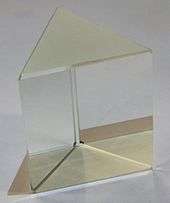
A dispersive prism can be used to break white light up into its constituent spectral colors (the colors of the rainbow). Furthermore, prisms can be used to reflect light, or to split light into components with different polarizations.
How prisms work
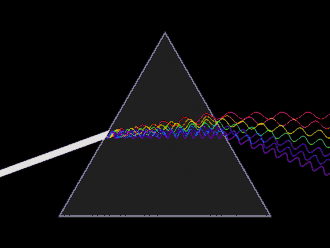
Light changes speed as it moves from one medium to another (for example, from air into the glass of the prism). This speed change causes the light to be refracted and to enter the new medium at a different angle (Huygens principle). The degree of bending of the light's path depends on the angle that the incident beam of light makes with the surface, and on the ratio between the refractive indices of the two media (Snell's law). The refractive index of many materials (such as glass) varies with the wavelength or color of the light used, a phenomenon known as dispersion. This causes light of different colors to be refracted differently and to leave the prism at different angles, creating an effect similar to a rainbow. This can be used to separate a beam of white light into its constituent spectrum of colors. A similar separation happens with iridescent materials, such as a soap bubble. Prisms will generally disperse light over a much larger frequency bandwidth than diffraction gratings, making them useful for broad-spectrum spectroscopy. Furthermore, prisms do not suffer from complications arising from overlapping spectral orders, which all gratings have.
Prisms are sometimes used for the internal reflection at the surfaces rather than for dispersion. If light inside the prism hits one of the surfaces at a sufficiently steep angle, total internal reflection occurs and all of the light is reflected. This makes a prism a useful substitute for a mirror in some situations.
Deviation angle and dispersion
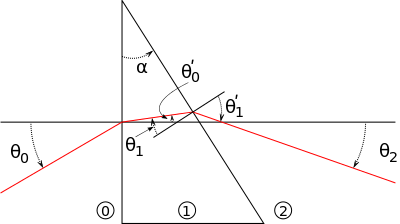
Ray angle deviation and dispersion through a prism can be determined by tracing a sample ray through the element and using Snell's law at each interface. For the prism shown at right, the indicated angles are given by
- .
All angles are positive in the direction shown in the image. For a prism in air . Defining , the deviation angle is given by
If the angle of incidence and prism apex angle are both small, and if the angles are expressed in radians. This allows the nonlinear equation in the deviation angle to be approximated by
The deviation angle depends on wavelength through n, so for a thin prism the deviation angle varies with wavelength according to
- .
History
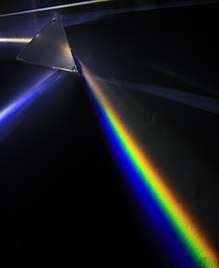
Like many basic geometric terms, the word prism (Greek: πρίσμα, romanized: prisma, lit. 'something sawed') was first used in Euclid's Elements. Euclid defined the term in Book XI as “a solid figure contained by two opposite, equal and parallel planes, while the rest are parallelograms”, however the nine subsequent propositions that used the term included examples of triangular-based prisms (i.e. with sides which were not parallelograms).[1] This inconsistency caused confusion amongst later geometricians.[2][3]
René Descartes had seen light separated into the colors of the rainbow by glass or water,[4] though the source of the color was unknown. Isaac Newton's 1666 experiment of bending white light through a prism demonstrated that all the colors already existed in the light, with different color "corpuscles" fanning out and traveling with different speeds through the prism. It was only later that Young and Fresnel combined Newton's particle theory with Huygens' wave theory to explain how color arises from the spectrum of light.
Newton arrived at his conclusion by passing the red color from one prism through a second prism and found the color unchanged. From this, he concluded that the colors must already be present in the incoming light — thus, the prism did not create colors, but merely separated colors that are already there. He also used a lens and a second prism to recompose the spectrum back into white light. This experiment has become a classic example of the methodology introduced during the scientific revolution. The results of the experiment dramatically transformed the field of metaphysics, leading to John Locke's primary vs secondary quality distinction.
Newton discussed prism dispersion in great detail in his book Opticks.[5] He also introduced the use of more than one prism to control dispersion.[6] Newton's description of his experiments on prism dispersion was qualitative. A quantitative description of multiple-prism dispersion was not needed until multiple prism laser beam expanders were introduced in the 1980s.[7]
Types of prisms
Dispersive prisms
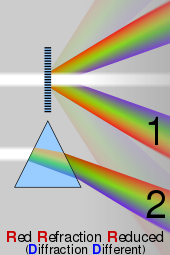
Dispersive prisms are used to break up light into its constituent spectral colors because the refractive index depends on frequency; the white light entering the prism is a mixture of different frequencies, each of which gets bent slightly differently. Blue light is slowed more than red light and will therefore be bent more than red light.
- Triangular prism
- Abbe prism
- Pellin–Broca prism
- Amici prism
- Compound prism
- Grism, a dispersive prism with a diffraction grating on its surface
Reflective prisms
Reflective prisms are used to reflect light, in order to flip, invert, rotate, deviate or displace the light beam. They are typically used to erect the image in binoculars or single-lens reflex cameras – without the prisms the image would be upside down for the user. Many reflective prisms use total internal reflection to achieve high reflectivity.
The most common reflective prisms are:
- Porro prism
- Porro–Abbe prism
- Amici roof prism
- Pentaprism and roof pentaprism
- Abbe–Koenig prism
- Schmidt–Pechan prism
- Bauernfeind prism
- Dove prism
- Retroreflector prism
Beam-splitting prisms
Some reflective prisms are used for splitting a beam into two or more beams:
Polarizing prisms
There are also polarizing prisms which can split a beam of light into components of varying polarization. These are typically made of a birefringent crystalline material.
- Nicol prism
- Wollaston prism
- Nomarski prism – a variant of the Wollaston prism with advantages in microscopy
- Rochon prism
- Sénarmont prism
- Glan–Foucault prism
- Glan–Taylor prism
- Glan–Thompson prism
Deflecting prisms
Wedge prisms are used to deflect a beam of light by a fixed angle. A pair of such prisms can be used for beam steering; by rotating the prisms the beam can be deflected into any desired angle within a conical "field of regard". The most commonly found implementation is a Risley prism pair.[8] Two wedge prisms can also be used as an anamorphic pair to change the shape of a beam. This is used to make a round beam from the elliptical output of a laser diode.
Rhomboid prisms are used to laterally displace a beam of light without inverting the image.
Deck prisms were used on sailing ships to bring daylight below deck,[9] since candles and kerosene lamps are a fire hazard on wooden ships.
In optometry
By shifting corrective lenses off axis, images seen through them can be displaced in the same way that a prism displaces images. Eye care professionals use prisms, as well as lenses off axis, to treat various orthoptics problems:
- Diplopia (double vision)
- Positive and negative fusion problems
- Positive relative accommodation and negative relative accommodation problems.
Prism spectacles with a single prism perform a relative displacement of the two eyes, thereby correcting eso-, exo, hyper- or hypotropia.
In contrast, spectacles with prisms of equal power for both eyes, called yoked prisms (also: conjugate prisms, ambient lenses or performance glasses) shift the visual field of both eyes to the same extent.[10]
See also
| Wikimedia Commons has media related to Prisms. |
References
- Elements: book 11, Def 13 and Prop 28, 29, 39; and book 12, Prop 3, 4, 5, 7, 8, 10
- Thomas Malton (1774). A Royal Road to Geometry: Or, an Easy and Familiar Introduction to the Mathematics. ... By Thomas Malton. ... author, and sold. pp. 360–.
- James Elliot (1845). Key to the Complete Treatise on Practical Geometry and Mensuration: Containing Full Demonstrations of the Rules ... Longman, Brown, Green, and Longmans. pp. 3–.
- James Gleick (8 June 2004). Isaac Newton. Vintage. ISBN 1400032954.
- Isaac Newton (1704). Opticks. London: Royal Society. ISBN 0-486-60205-2.
- "The Discovery of the Spectrum of Light". Retrieved 19 December 2009.
- F. J. Duarte and J. A. Piper (1982). "Dispersion theory of multiple-prism beam expanders for pulsed dye lasers". Opt. Commun. 43 (5): 303–307. Bibcode:1982OptCo..43..303D. doi:10.1016/0030-4018(82)90216-4.
- Duncan, B.D.; Bos, P.J.; Sergan, V. (2003). "Wide-angle achromatic prism beam steering for infrared countermeasure applications". Opt. Eng. 42 (4): 1038–1047. Bibcode:2003OptEn..42.1038D. doi:10.1117/1.1556393.
- Loenen, Nick (February 2012). Wooden Boat Building: How to Build a Dragon Class Sailboat. FriesenPress. ISBN 9781770974067.
- Kaplan, M; Carmody, D. P.; Gaydos, A (1996). "Postural orientation modifications in autism in response to ambient lenses". Child Psychiatry and Human Development. 27 (2): 81–91. PMID 8936794.
Further reading
- Hecht, Eugene (2001). Optics (4th ed.). Pearson Education. ISBN 0-8053-8566-5.
External links
- . Encyclopædia Britannica. 22 (11th ed.). 1911. p. 361.
- Java applet of refraction through a prism